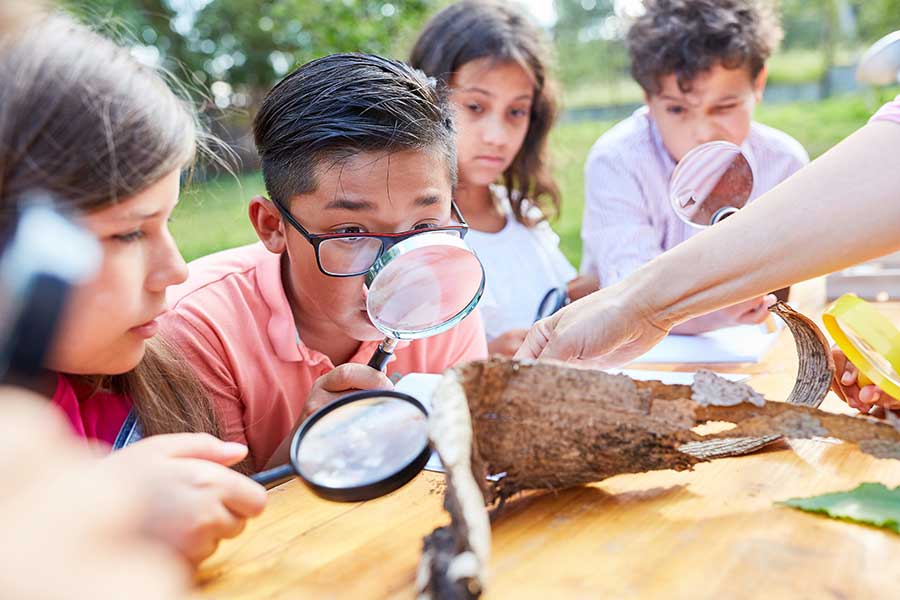Environmental Science: Let’s Get Outside and Learn!
Environmental science in summer
Some of my fondest childhood memories are making mud pies under the thick canopies of evergreen trees—and eating green onions straight from the garden. Back then, I found it strange how my mother knew I was the one digging up vegetables faster than she could plant them. The bunnies and I happily ate through the garden, leaving no harvest behind.
Was my onion breath the real giveaway?
Or the results of my foiled plan? I would eat most of the onion but leave enough of the stem—and replant it—so my parents wouldn’t know I ate our entire garden. This tactic appeared clever to my five-year-old self. However, when they pulled the spring onions, they found the bulbs were “missing” and the remnant of gnawed-off stems.
Whoops.
Nature is the perfect teacher
Growing up, dirt was for digging, playing, and rolling around. I had more pine needles in my hair than I did strands on my head. Though there are mountains of research proving children benefit from being in nature, I am proof that it enhances educational opportunities and cultivates a love for our planet throughout life. So how did my outdoor experience shape my adult life?
- I consume significantly more fruits and veggies than the average person (or five)
- I’m still happily digging and playing in the dirt
- To me, hiking is as thrilling as any vacation
- I strongly support and adhere to Leave No Trace practices
- I have a strict catch-and-release policy. Bugs aren’t harmed in my home; instead, they are released outdoors to their habitat
- I invite others to share in my love of nature, and hopefully, they catch the nature bug too
- I spend significantly more time outdoors than indoors
- I have a deep (and I mean deep) appreciation of our planet
- Not only do I recycle, I upcycle and try to find ways to reduce my consumption
And these are only some of the effects nature had imprinted on me. My childhood was ordinary. The only difference was that I was encouraged to explore. Imagine the effects more exposure, ideas, and encouragement could have on a child.
If you are an adult that cares for a child in any capacity, even the smallest amount of environmental exposure will be an incredible investment for them now and in the future.
Preserving fun and fresh air
So, what exactly is environmental science?
Environmental science is the study of how living organisms and their environment interact. Scientists study both natural environments, such as ecosystems and habitats, and human-made environments, such as cities and industrial sites.
Humans impact the environment in many ways. Over time we have certainly veered towards overconsumption, and it is important to realize how dangerous pollution, fossil fuel use, or unsustainable development practices can be. After all, humans are part of nature and we must understand how important it is that we realize nature and ourselves are really the same thing. Everything is connected! It can feel overwhelming when we consider trying to restructure so much of the world we live in to make it a more equitable and sustainable place. Teaching children about the environment or climate change can be very emotional. Educating children about the environment and encouraging them to enjoy it is a huge step for our future generations. Focusing on the beauty of our planet, and our ability to protect it and treat it well, is not only educational, but it is also empowering. We all can learn a lot from the great outdoors. And by spending more time outside, we can truly stop to smell the roses and appreciate the small stuff.
Ideas for getting out—and staying outside—this summer with your little explorer:
Energize and inspire your little explorer! Lemberg Cloud has developed an environmental education curriculum for children in preschool through second grade, but the curriculum can also easily be adapted for children ages three through ten.

Environmental Education and Gardening with Children
A Curriculum for Resilience, Empathy, and Health
by Janet Fuchs
The environmental education curriculum is an ideal resource for teachers, parents, and community organizers. There are 50 environmentally-friendly activities included in the guide, along with a carefully selected list of books and online resources.
Learning opportunities are maximized during different times of the year by grouping activities according to season. Educators and parents can confidently lead environmental studies—indoors and out—with this set of lessons.
For $19.95, you can download the full e-book jam-packed with activities. Additionally, your purchase supports the Lemberg Firefly Scientists’ learning garden and environmental educators.
Get a sneak peek at Lemberg Cloud’s Environmental Education and Gardening with Children by downloading these 4 free lessons
1. Bug Hunt: Insects, Worms, Caterpillars, and Butterflies
2. What Is A Plant and What Is Not A Plant?
4. A Fungus Among Us: Exploring Mushrooms
Go beyond mud pies
If you have a garden area, the environmental science curriculum provides step-by-step lesson plans to build connections with nature, healthy food choices, environmental stewardship, and essential life skills. Additionally, our book offers online resources for those considering building a learning garden to help you get started. Even if you do not have a garden space of your own, there is so much to learn from exploring public parks or garden spaces. Cracks in the sidewalk can be found to be teeming with life! Our curriculum focuses on prompting children to observe the world around them to think about how they impact the Earth, and how the Earth impacts them.
Through these multi-sensory, hands-on activities, children develop an understanding of the connection of all living things while building social skills and values such as:
- Self-reliance
- Responsibility
- Observation and reflection
- Perseverance
- Curiosity
- Caring
- Gentleness
- Collaboration
- Emotional regulation
- Empathy
Your Outdoor Classroom
By exposing children to the world around them through play and exploration, you can give them a foundation of knowledge that will serve them for life. Children who get an early start on learning about the environment around them are more likely to grow up to be thoughtful and environmentally aware adults. In addition to creating memories, these activities can teach kids important skills like how to plan ahead, being observant, and working as a team. Don’t limit yourself to just hiking and camping, though! There are lots of games out there that can help you explore nature together.
There is no better way to encourage environmental stewardship than by encouraging children to become involved in their own backyard, neighborhood or park. From planting seeds in a small garden plot to learning how to care for a tree and pruning it properly, children learn valuable lessons about conservation every step of the way. Plus, there are all kinds of fun things you can do with your child’s help behind the scenes. How will you play in the dirt this summer?

